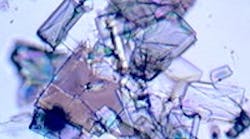MOMS CLOSE UP
Figure 1. Metal-organic crystals, shown here under microscope, beckon as an efficient, less expensive and reusable material for carbon capture and separation. Source: USF/Mike Zaworotko.
SIFSIX-1-Cu, the material the USF-KAUST team developed, contains a metal center coordinated to a multifunctional organic ligand in a three-dimensional lattice, and provides extensive surface area. Unlike existing materials, it resists water, says USF chemistry professor Mike Zaworotko, who led the project.By control of pore functionality and size, the material attains the "sweet spot" of kinetics and thermodynamics, offering high volumetric uptake at low CO
2 partial pressure, say the researchers. More importantly, they add, it offers unprecedented CO
2 sorption selectivity over N
2, H
2 and CH
4, even in the presence of moisture. More details appear in a recent article in
Nature.The material not only resists poisoning from water, but also requires less energy to recycle compared to previous benchmark materials. However, Zaworotko notes that whether the material can be reused numerous times with little or no loss in performance remains to be determined."Our materials are the new benchmark for selectivity towards CO
2. However, recyclability in the real world and cost when produced at scale remain to be evaluated. These matters could be addressed by modifying the prototypes if necessary, but this would in turn require more research before development can occur. The amount of heat generated is also something that will have to be optimized if there is an issue with the prototypes," he explains.The team already is collaborating with engineers to determine how to manufacture the materials and apply them to real-world uses. Testing of a production process on a laboratory scale could begin within a few months, but pilot-scale testing will require industrial partners, says Zaworotko.The plan is to initially try the material for syngas purification, as well as for removal of CO
2 from enclosed environments. "Flue-gas is definitely of interest, too, but is a longer-term goal," he notes. The material potentially could be used to capture carbon in coal-burning energy plants, purify methane in natural gas wells and advance clean-coal technology."An advantage for some applications (e.g., where zeolites are currently used) is that no new plants/processes in terms of CO
2 removal would be required. We would simply replace existing porous materials where they are currently used. There could therefore be a short path from discovery to end use. Implementation in terms of clean coal would take much longer because there is not yet a commercial process that is in widespread use (although technologies related to chemical CO
2 capture are being tested on a pilot scale)," he adds.The ultimate goal, says Zaworotko, is to find ways to chemically convert CO
2 to a more useful and valuable product in a second step. "Carbon capture is just one possible use for porous materials. That we have the ability to design porous materials from first principles will create opportunities for any process in which porous materials currently play a role and will also create the possibility of revolutionary new technologies in other areas of societal impact such as natural gas transportation and storage. The next five years promises to be exciting for MOMs," he concludes.
